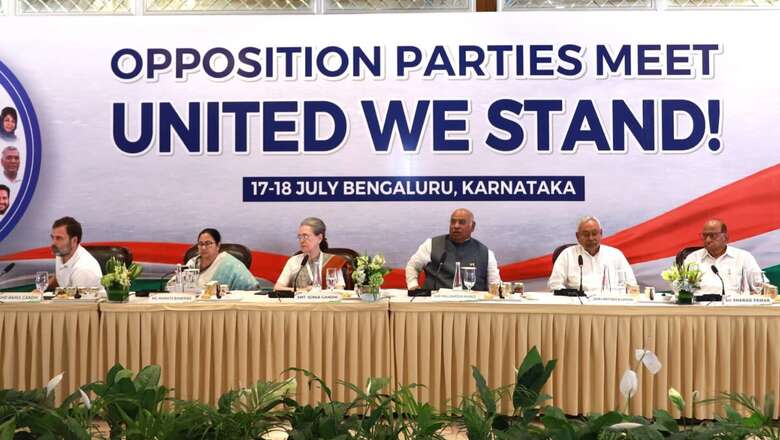
views
Will it be a ‘developmental’ INDIA versus a ‘developed’ Bharat in 2024? Having come up with a fanciful acronym for itself — ‘INDIA’, where the ‘D’ stands for ‘developmental’ — the Opposition has willy-nilly put nationalism and development at the heart of its agenda. It is for the alliance to explain how it can do better than the NDA on both these counts.
Will ‘developmental’ India be an upgrade of ‘Viksit Bharat’? Bharat eagerly awaits clarity on what INDIA stands for — and so do the alliance members, some of whom thought the ‘D’ in INDIA stood for ‘Democratic’.
INDIA’s confusion about its own name points to the diffuse nature of the alliance and its total lack of self-conception. ‘Democratic’ may actually have worked better for INDIA, as one of its main planks is ‘save democracy’.
On the ‘developmental’ front, Prime Minister Narendra Modi, the original ‘Vikas Purush’, took a dig at the Opposition when he said NDA stood for ‘New India, Development, Aspiration’. No confusion there!
How far does INDIA represent India? Not very well. The footprint of the so-called ‘26-party alliance’ is much smaller than it looks. Five of the 26 parties belong to Tamil Nadu alone, four to the Left, three each to Kerala and Uttar Pradesh, and two each to Maharashtra and Bihar. Four of the parties are largely confined to a single state. That leaves the Congress as the sole representative of the alliance in the Northeast, Rajasthan, Gujarat, Madhya Pradesh, Chhattisgarh, Uttarakhand, Himachal Pradesh, Haryana, Odisha, Andhra, Telangana, Karnataka, Goa and Puducherry.
In other words, the Congress will represent the alliance in 224 Lok Sabha seats, of which it currently has only 15. Of the remaining states, where the alliance is represented by regional parties (with or without the Congress), its strength is not uniform. In Kerala and Tamil Nadu, it reigns supreme but in UP and Maharashtra — which together account for 128 seats — its presence is thin. The Opposition Shiv Sena (UBT) and NCP represent only the rump of their respective parties in Maharashtra, while in UP, the vote share of ‘Bharat’ (NDA) in the 2019 general elections was double that of INDIA (SP + RLD + Congress).
So, geographically, the alliance is not very well represented. This is because the BJD (Odisha), BSP (UP), YSR Congress and TDP (Andhra), TRS (Telangana) and JD(S) (Karnataka) — not to mention parties of the Northeast — are apparently not a part of INDIA. In that sense, it’s more of an ‘anti-BJP’ than an ‘Opposition’ alliance.
Anyhow, the alliance finally has a name and now the hard work begins: first, drafting a common minimum programme (CMP) and talking points; second, arriving at seat-sharing arrangements in each state; and third, deciding on a face, or faces, for the campaign. As election analyst Prashant Kishor pointed out, “Electoral success is only possible when these parties have a programme which they take to the public…even in 2019, all Opposition parties came together. How does it matter?”
Let’s consider the CMP and how it might be different from the NDA agenda. So far, all we have heard is the usual tropes: majoritarianism, intolerance (of free speech), and abuse of power. It’s time to get down to brass tacks. Where does INDIA stand on economic reforms? We have seen sharp differences between alliance members on critical issues like labour reforms, agriculture and the Old Pension Scheme for government employees. None of these can possibly be ignored in a CMP. If the alliance comes to power, will it build on all that the NDA has done in terms of financial inclusion? What is in store for the UPI (recall that Congress leader P Chidambaram was not in favour), India Stack and IndiaChain? Will it continue the NDA’s flagship programmes like Digital India, Make In India, the National Semiconductor Mission, Gati Shakti, Circular Economy and Swachh Bharat? How about welfare schemes like Ujjawala, Awas Yojana and Har Ghar Jal?
Where do the alliance partners stand on a Uniform Civil Code, Article 370, the Citizenship Amendment Act and the National Census Register? Will the law on triple talaq be diluted? Will the National Judicial Commission be revived? Can we expect continuity in foreign policy, or will new-found friends be snubbed?
A lot hinges on the CMP and how well it is communicated to niche audiences, but even more on seat-sharing arrangements. The Aam Aadmi Party (AAP) and the Congress will have to carve up Delhi and Punjab, after having been at daggers drawn. The Trinamool Congress (TMC) will have to accommodate a laundry list of parties it despises in West Bengal. The Janata Dal (United), Rashtriya Janata Dal (RJD), Congress and Left will all vie for space in Bihar.
Finally, who will front the campaign? Clearly, it’s going to be Modi versus the rest, which doesn’t help the Opposition. In the absence of a tall leader, it needs to come up with a big idea, a crackerjack agenda that can capture the imagination of voters as effectively as Narendra Modi’s ‘Amrit Kaal’.
Bhavdeep Kang is a freelance writer and author of ‘Gurus: Stories of India’s Leading Babas’ and ‘Just Transferred: The Untold Story of Ashok Khemka’. A journalist since 1986, she has written extensively on national politics. Views expressed in the above piece are personal and solely that of the author. They do not necessarily reflect News18’s views.

















Comments
0 comment